Editorial
I actually got quite excited for a moment, thinking this month marked MEN's Tenth Anniversary in the current monthly release format. Turns out it's only nine years, though MEN began in a less "formal" format way back in 1998. On the positive side, this gives me another year to decide what the special ten year anniversary gift to Members will be. By they way, the public MEN web site now consists of 999 different pages. I could have squeezed in another to break the ton as it were, but all nines is a good number too. Next month, we enter four figure territory.
On the home front, it's winter Downunder with a vengeance. Would you believe the temperature fell to 12°C (56°F) this morning? Now that's what we call cold! Don't know if I can blame it on the weather, but my old HP scanner has gone belly up during the month. This prompted me to look at new ones and find that the bottom has dropped out of the scanner market. The offerings from the manufacturers are few and very pedestrian. Looks like they want us all to buy their three-in-one printer, copier, scanner offerings instead. Well I just want a good scanner, not something that eats expensive consumables like chocolate. With luck, the scanner problem will be a dried out electrolytic capacitor and I can restore it to normal function by brute force engineering (replace every electro in sight). Otherwise, I'll have to settle for something inferior to what has served me reasonably well for the past six years; (grumble) and we call this progress.
For my sins at the University, I've been tasked with designing and building some "apps" for the iPhone and iPad. The learning curve has been steep, but quite enjoyable, even though Apple has a rather peculiar business model for the distribution of third party apps (you pay $100 a year for the privilege of uploading an app to their store, from which they take 30% off the top of the sale price for each copy sold). The development tools however are really excellent, and free. Already I'm wondering what I can design on the iPhone for Model Engineers (a world-wide market potential of maybe a dozen individuals, probably  ).
).
Many thanks to those who continue to ask after my health. The last two chemo-poisioning sessions have had no significant side effects whatever, ignoring for the moment that my sense of taste is well and truly screwed. Beer tastes awful; wine goes metallic after a very small glass. Even coffee has lost it's appeal. It may be trivial in the big scheme of things but I count my quality of life as being at an all time low.
Lastly, I need to come clean and confess that I've quietly changed the currency used for the Model Engine News Life Membership, and the Motor Boys' Plan Book on CD. Both are now billed in Australian dollars, rather than US funds. For most of this year, the once impoverished Ozzie dollar has been trading at around US$1.06 and higher. A "leading economic forecaster" (be afraid, be very afraid) thinks US$1.40 is not out of the question in the next year, 'though I'd be watching the skys closely for formations of pigs first. We are not talking sheep stations here and I won't be retiring to Rio on the proceeds, but Australia Post has been steadily sneaking up the cost of postage, so just changing the exchange currency lets me maintain the numbers for now. Life Membership is now AU$75.00 international, and AU$70.00 domestic. Upgrade DVD's are AU$15.00 and the MBI CD is AU$20.00. All include world-wide air postage. Proceeds pay for the operating costs of the web site and without them, we could not survive.
Vale David Janson
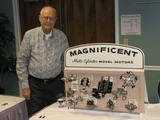
Sad news from the US that David Janson passed away on May 25, 2011. David will be known to readers of these pages through the model engine reviews he published in MECA news letters and later compiled into a self published book (see MEN, August, 2006), generously encouraging people to copy pages as required and distribute freely. MEN has done just this with several noteworthy engines, converting David's original text to HTML pages using optical character recognition (OCR) software, and replacing his black and white photos with high definition color photographs, as close as possible to the originals. David, who signed his letters as "the only Republican living in Boulder, CO", thus leaves a wonderful legacy; click here for the David Janson's Model Engine Designer and Manufacturer Profiles index page.
Olds 10cc
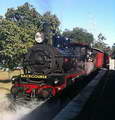
David Owen has found us a very rare and unusual pre-WWII Australian sparker for this month. As you'll discover on the OLDS 10cc Ignition page, the manufacturer was located in a town named Maryborough, Queensland (a state noted for sugar cane, banana bending, and strip mining). Although outwardly a small country town in sugar cane territory, Maryborough has been home to some surprising heavy industry, including Walkers Ltd, renown for shipbuilding and the rolling stock made for the Queensland Government Railway, from the glorious days of steam, right up to modern high-speed, diesel-electric and pure electric times. As a "flying engineer" for good old International Computers Ltd (ICL) in the 1970's with my own aircraft (a Mooney M20E), I visited Walkers, who were an ICL mainframe computer user, on several occasions to support the on-site engineer with hard problems. On one visit I received a tour of their casting shop where some sort of giant gear wheel was being sand case in the open. Today I'd be spell-bound, back then it was just mildly interesting; my how times change...
Zimmerman, Profi, Hende
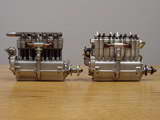
It's always nice to fill in the blanks on some partly understood story. It's even better when some knowledgeable guy like Paul Knapp does it for you! The item in question is a very nicely made example of the Zimmerman Cirrus Mk I in 1/6th scale as depicted in our Gallery photo. It actually was built for Arne Hende by Profi ME. Arnie contracted them to build some of the Zimmerman style Cirrus engines and somewhere along the line they produced the version seen on the Gallery page. Our photo here shows the engines produced by Merrit Zimmerman himself. The main difference from Merritt's Cirrus and the Profi Cirrus is the castings; Profi produced the castings using the lost wax method. Merritt sand cast his engines.
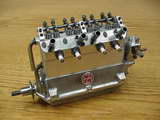
As mentioned in the David Janson Zimmerman Cirrus review, Merrit himself made a number of engines for sale to collectors and users. Paul provided some photos of Merritt's water-cooled Cirrus engines, which comprised about eight out of the seventy-five or so engines he completed. For comparison, the previous photo shows both the air-cooled and water-cooled versions. For their water-cooled models, Profi thoughtfully added a rear mounted water pump. The "real" Zimmerman engine—note the stylized "Z" on the side of the engine—lacked this refinement.
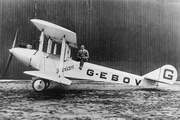
Incidentally, we mentioned the Queensland town of Maryborough in the previous article. Travelling north, the next town, not much larger, is Bundaberg, home of Australian aviation pioneer, Bert Hinkler. In 1928, Hinkler made a solo flight from England to Australia in just 128 flying hours spread over 15 days, smashing the previous record. The aircraft he flew was an Avro Avian, registered G-EBOV. This he donated to the Queensland government in 1929 and it has been on constant display in the Queensland museum ever since I can remember. Last month I had another look over her while attending the launch of a biodiversity web site we are involved with, held in the Museum gallery. This is worthy of mention because the Avian was powered by, guess what,, Frank Halford's little 85 HP Cirrus Mk I!
Gnome
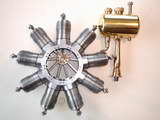
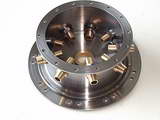
Being partial to the dreadful pun, I was tempted to say Gnome, but not Forgotten, but there are limits! For quite a while now, fellow Motor Boy, Les Stone, has been building the Chenery Gnome rotary and has just sent in some progress shots showing the end is, if not in sight, at least around the next corner. Les is no stranger to multi-cylinder "round" engines having previously build a Hodgson seven radial, and three cylinder Anzani "fan" radial, but the nine cylinder Gnome rotary poses entirely new challenges. The photos here show Les' recent progress on the engine, fuel/oil tank, and cam box. The cams themselves (one per cylinder on the Gnome) and roller tappets are yet to come, but as can be seem the majority of the repetition work is now done.
I especially admire the attention to detail Les has expended on the fuel and oil tank. Les is famous (infamous?) for his highly polished engines and ornamental work on the accessories, a feature apparently not wasted on the judges at shows where Les has exhibited in the past. And even though they look like glass case models, all of Les' engines are runners! The Gnome will be no exception. If you've never seen a big rotary model run, they can be a bit frightening—and don't stand to the side where the total loss oil system throws out a mist of castor. We look forward to seeing Les' engine in action sometime not too far away.
The Titans
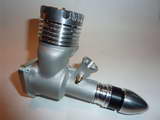
For some time, our Engine Finder has carried an entry for George Genervo's Titan .60, but this has been a simple link to a photo. The engine itself has been mentioned a number of times (search on "titan" and don't forget to turn on whole word matching or you'll get a lot of extraneous titanium entries as well). I've always felt rather guilty about this because the engine is a good, honest project which could almost be a beginner project, needing no milling, nor thread cutting. Hence I'm rather relieved to at last present a page with a few words about the engine, prompted by some new photos provided by Rob Jenkins. Rob's rendition of the Titan is per the plans, though he has done an excellent job of presentation through some blasting of the case and bringing out the details. Visit the Titan .60 page for more information.
Metamorph 60
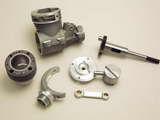
This collection of bits assembles (hopefully) into a Rustler Merco Metamorph .60 AAC. The photo and some details on the engine were sent by Charlie Stone who obtained the engine from Ian Russell (UK). Some years back (2002), Ian wrote an article on Merco engines for Model Engine World, a version of which is no on-line (unusual in the extreme for any MEW content; click here for Ian's "Starting a History of Merco" text). A bit more digging found a reference to the engine in the excellent pdf webzene, Stick and Tissue, January 2010. The issue contains a list of engines then available from Ian which includes our subject, listed £125.00. It's an unusual and rather nice looking beast, so Charlie's photos have been assembled to a small page on it; click the thumbnail to visit, or use the Engine Finder, which now boasts 439 entries.
New Books and Magazines This Month
This month's Tech Tip has made me think about small workshop tools of the shop-made variety. These are useful in themselves, although their main value to the beginner is as exercises to develop required skills at little cost. Making such items was once de rigueur for the Model Engineer. Today, many of these can be obtained by throwing money at the problem. Others however will only ever be obtained by making them yourself and somehow, I always get a smug sense of satisfaction when a tool I've made myself does the job better than a bought one. As nothing of great significance was inserted into The Library this month, these thoughts led me to the shelf where sits my collection of those little Workshop Practice Series books, one of which is devoted to just this subject.

Making Small Workshop Tools, by Stan Bray, Trans-Atlantic Publications Inc, 1987, ISBN 0852428863, is Number 14 in the now quite extensive "Workshop Practice Series", first launched by the publishers of the Model Engineer (see MEN, April, 2010 for a capsule history of the series). Author, Stan Brey, is a former Editor of the ME's companion magazine, Model Engineers' Workshop, and a contributor in years past the the ME itself through his occasional column, Brey's Workbench. His book spans 96 pages, divided into three chapters in which he covers marking-out tools, benchwork, and lathe accessories. In these, he describes twenty-two different workshop devices, most of which can be made from the scrap box! These range from the ultra-simple such as scribers and odd-leg callipers, to the more sophisticated like a filing rest, a calliper-type knurling tool, and a nice little box-tool. All are illustrated with very nicely drafted plans, photographs of components, and of the tool in use.
Now, ask yourself: are you really going to make a scriber, or a center punch? Maybe not (though he mounts a convincing argument for a heavy shop-made scriber that tempts me strangely). Even if you don't make your own center punch, reading Stan's one page description will explain why some have a 60° point, while others have a 90° point and Why This Is So (as Prof Julias Sumner Miller might have said). The box-tool is nice, though it may be a better source of ideas than a tool unto itself. His clamp for thin plate is one of those things I swear I must make next every time I need to hold down some thin plate for drilling. A filing rest, for those who are wondering, is a attachment which can be positioned around some stock held in the lathe chuck that supports your file parallel to the bed at an adjustable height, giving some assurance that rocking and rolling of the file will be prevented and a flat surface result. If the process is repeated a few times with the stock rotated 90° each time, a perfectly regular and centered square end can be quickly made by hand. Such devices were once a common workshop accessory, though many today resort to the vertical mill and a rotary table to produce the same job in twice the time, making this another gadget I really should make, someday.
This is not an earth-shattering work, but it does have the advantage having a dedicated and experienced Model Engineer for an author who spends more time describing why a tool is designed the way it is and how it works, rather than how to make it—in fact he often skims over actual construction, declaring it too obvious for words. For this reason alone, Stan Brey's Making Small Workshop Tools deserves Four Stars and a place on your bookshelf  .
.
Engine Of The Month: The McCoy Diesels
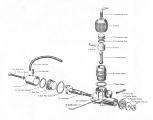
Ever since it's introduction, the glow plug has been the undisputed King in US model engine design, but this has not stopped a remarkable number of US manufacturers from flirting with compression ignition (or "diesel" as we like to label them). Over time, Adrian Duncan has given us in-depth views of most of these efforts and this month, he looks into what turns out to be one of the best of the breed: the McCoy 049 and 099 diesels. Like the OK Diesels, Dick McCoy chose a high temperature O-Ring to seal his contra-piston, a design poo-poo'd by purists, but one which works surprisingly well. As far as I can recall, only one British manufacturer dallied with the O-Ring and was roundly caned by the modelling public who preferred to exercise their manly strength and burn their fingers while adjusting the compression setting, claiming the O-Ring type destroyed the "feel" of the compression screw (quick: for five bonus points, name the manufacturer—the answer is in these pages). In his test, Adrian takes us through the various models and compares the McCoy with what would have been the best of its British contemporaries, with some surprising results!
Tech Tip of the Month
On of the most frequently asked questions in the MEN in-box is ...what do I need to start making model IC engines?
You don't need a mill
You don't need a coolant pump
You don't need a fixed steady
You don't even need a travelling steady
And you most definitely don't need a taper turning attachment!
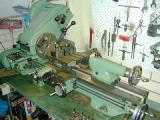
With that out of the way, what do you need? Well sit down and take a deep breath because the list, while not that large, is going to make a fair old hole in your savings. The lathe will be a big ticket item, but you'll need to spend almost as much again on tooling and accessories! Here it pays to shop around and be patient. You may even be lucky enough to find a suitable machine as a deceased estate in which case you'll probably find yourself with all you need, several things you don't need (including a dusty, unused taper turning attachment), and a host of things whose purpose is a total mystery.
Figuring that is was way past time to give a carefully considered answer to the question for once and all, and in a vein attempt to write an article with more photographs than an Adrian Duncan Engine Review, a new page has been added with my thoughts on just what is required to tackle a typical beginner engine project like the ML Midge, or BollAero. Visit the new Kitting Up To Make Model IC Engines - Part 1 page to see what your humble editor believes is and isn't required, and hopefully, why!
Briefly Noted
This section is intended to alert you to little things that are hard to expand to a full news item, or cunningly wind into the Editorial, but are worthy of note never the less.
- News from Owen Engines Australia that the re-released MP Jet .061 diesels are expected in stock at the start of June. See the Owen Engines Price List for more details.
- There's a new Watzit for you to scratch your grey cells over this month. We have no ide what it is!
- A number of Adrian's engine reviews have been significantly updated. Revisit the following: the Alag, the AMCO 35, the Milford Mite, and the NZ Katipo.
 Editorial
Editorial
 New Books and Magazines This Month
New Books and Magazines This Month
 Engine Of The Month: The McCoy Diesels
Engine Of The Month: The McCoy Diesels
 Tech Tip of the Month
Tech Tip of the Month
 Briefly Noted
Briefly Noted
 Standard Stuff
Standard Stuff


 ).
).










 .
.

